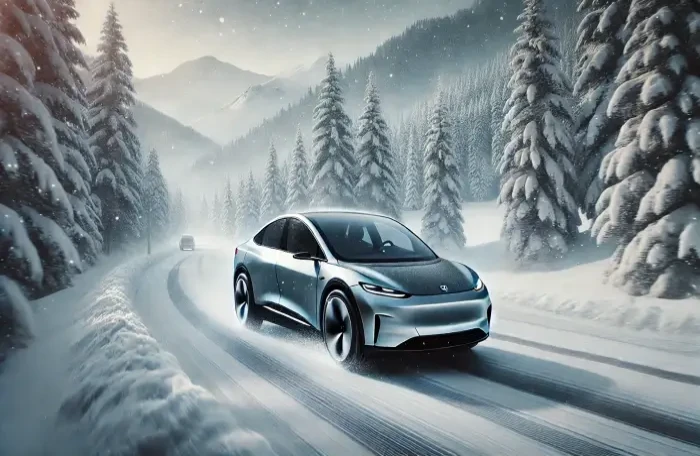Essential Winter Driving Tips for Electric Vehicle Owners

Lila Claybourne
Sep 23, 2024

Winter Driving Tips for Electric Vehicles: Comprehensive Guide
The Impact of Winter on Electric Vehicles
Winter poses significant challenges for electric vehicle (EV) drivers. Cold temperatures impact battery performance, reducing range and efficiency, while slippery road conditions demand more caution. A study by the American Automobile Association (AAA) found that EVs can lose up to 41% of their range in cold weather as battery efficiency decreases, and heating systems consume extra power. Consumer Reports also noted that 70% of EV drivers experience performance issues in winter, particularly in regions with extreme cold.
To ensure your EV operates efficiently and safely during the winter months, this guide will explore essential strategies, advanced maintenance tips, and practical advice tailored to electric vehicle owners.
How Winter Affects Electric Vehicles
The Science: Lithium-Ion Batteries in Cold Weather
Lithium-ion batteries in EVs rely on chemical reactions involving the movement of lithium ions between electrodes. In cold weather, these chemical reactions slow down, making it harder for the battery to store and release energy. This reduction in efficiency not only shortens driving range but also affects charging times.
Battery Reaction Slowdown: Cold weather causes the electrolyte inside the battery to thicken, hindering the movement of ions and reducing overall performance. The thermal management systems in some EVs can mitigate this but require additional energy, further reducing range.
Slower Charging: Lithium-ion batteries charge more slowly in cold temperatures, especially at fast-charging stations. However, pre-conditioning your battery can improve charging speeds (more on this below).
The Importance of Battery Preconditioning for EV Owners
Pre-conditioning your EV’s battery is essential for maximizing range and improving charging efficiency, especially on long trips. Pre-conditioning heats the battery to an optimal temperature before driving or charging, ensuring better performance and faster charging speeds.
Faster Charging on Long Trips: Cold batteries take longer to charge at fast-charging stations. By pre-conditioning your battery, you can maintain a higher charging rate, especially at DC fast chargers.
How to Enable Preconditioning:
Tesla: Pre-conditioning can be activated through the Tesla app under the "Climate" tab. For long trips, you can also set the destination in the car's navigation, which will automatically start pre-conditioning the battery when approaching a Supercharger station.
Nissan Leaf: Nissan’s "Remote Climate Control" feature, available via the NissanConnect app, allows you to preheat your car’s cabin and battery while it’s plugged in.
Chevrolet Bolt: Use the "Energy Saver" mode while pre-conditioning through the myChevrolet app to avoid unnecessary battery drain before starting your trip.
Winter Driving Tips for Electric Vehicles
1. Install EV-Optimized Winter Tires
Winter tires are crucial for maintaining control on icy and snowy roads, but for EVs, it's important to choose tires that are both energy-efficient and provide adequate traction.
Recommended Tires: Consider tires like the Michelin X-Ice Snow or Bridgestone Blizzak WS90, which are optimized for winter driving. These tires offer superior grip while maintaining efficiency. Additionally, some models feature aero-optimized wheels, which minimize drag and improve range in cold weather.
2. Optimize Charging Habits
Charging your EV more frequently in winter is key to ensuring you have enough range for unexpected weather-related delays. Keeping the battery between 20% and 80% charged, as recommended by manufacturers like BMW, helps prolong battery life and reduce range loss.
3. Adjust Heating and Cabin Settings
To conserve energy, limit the use of cabin heaters and rely on more efficient options like heated seats and steering wheels.
Real-World Example: In a test by Auto Express, using heated seats and steering wheels instead of the cabin heater resulted in up to 15% better range retention for a Nissan Leaf.
How to Maximize EV Range in Winter
Maximizing range during the colder months requires optimizing both vehicle settings and driving habits:
Use Eco Mode: Most EVs, such as the Hyundai Kona Electric and Kia Niro EV, offer an "Eco" mode that reduces energy consumption by limiting acceleration and optimizing power usage. This feature can extend your range on longer trips.
Drive Smoothly and Steadily: Sudden acceleration and braking use more energy. Anticipate stops and coasting whenever possible to maximize regenerative braking. Regenerative braking recaptures energy lost during braking, but make sure to adjust its intensity on icy roads to avoid sudden stops that could lead to skidding.
Avoid Cruise Control on Icy Roads: Cruise control can make it harder to handle the vehicle when sudden acceleration or braking is needed. It's safer to manually control your speed and use light braking on slippery surfaces.
Winter Maintenance for EVs
Maintaining your EV in winter requires more than just basic care. Here are some additional maintenance tips to keep your EV running smoothly:
1. Install Mud Flaps to Prevent Snow Buildup
Mud flaps help prevent snow and ice from accumulating around critical sensors and cameras, which are essential for features like automatic emergency braking and lane-keeping assist.
2. Apply Protective Wax to the Vehicle's Exterior
Winter road salt and grime can damage your EV’s exterior paint. Applying a winter-specific protective wax provides a barrier against these elements and keeps your vehicle looking its best.
3. Check for Aero-Optimized Winter Tires
Winter tires are essential, but pairing them with aero-optimized wheels helps reduce wind resistance, allowing your EV to maintain efficiency. Some tire models, such as the Pirelli Sottozero with aero-enhanced designs, are built to balance safety and efficiency.
Safety Tips for Winter EV Driving
Adjust Regenerative Braking
Regenerative braking, while great for recapturing energy, can be too aggressive on slippery roads. Many EVs, such as Tesla and the Ford Mustang Mach-E, allow drivers to adjust the level of regenerative braking. In icy conditions, set regenerative braking to "Low" to avoid sudden stops that can cause skidding.
Avoid Cruise Control on Icy Roads
Using cruise control can be dangerous on icy or snowy roads. Cruise control maintains a constant speed, but you might need to slow down or brake quickly. It's better to drive manually in winter conditions to maintain better control.
Winter Emergency Kit for EV Drivers
A comprehensive emergency kit is essential for winter driving, especially in remote areas. Here's a detailed checklist of must-have items for EV owners:
Water-Resistant Clothing: Keep insulated, water-resistant clothing in your vehicle in case you need to spend extended time outside.
Blankets and Hand Warmers: Ensure you have enough blankets and warmers to keep warm if stranded.
Portable EV Charger: The BoostEV portable charger provides up to 25 miles of additional range, which can be crucial in emergencies.
Emergency Triangles: Set these up around your vehicle if you need to stop on the side of the road in poor visibility.
Tire Chains: For regions with heavy snow, tire chains can be a lifesaver for extra traction.
EV-Specific Apps: Apps like PlugShare and Greenlots help you locate nearby charging stations in case of emergencies.
Phone Chargers and Flashlights: Keep extra phone chargers and flashlights in your vehicle for communication and visibility.
AmeriFreight’s Role in Helping EV Owners
If winter driving feels too risky, especially during cross-country moves or relocations, shipping your EV may be a safer option. AmeriFreight offers specialized car shipping services that cater to electric vehicles, ensuring they are transported safely in challenging weather conditions.
Get an instant quote from AmeriFreight to transport your EV, avoiding winter road hazards and wear and tear.
By following these expert-backed tips, you can drive your electric vehicle safely and efficiently during the winter months. From pre-conditioning your battery to installing the right winter tires, these strategies will ensure your EV stays reliable, even in harsh winter conditions.
Related Posts
















